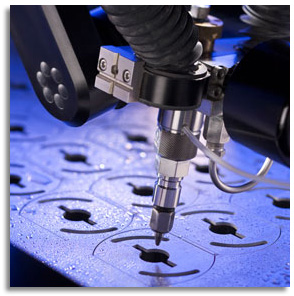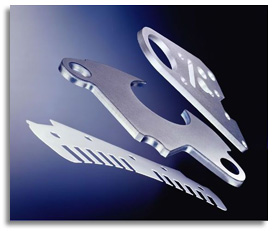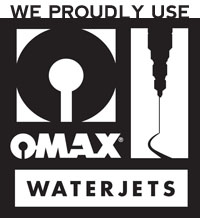FAQ
What are the capabilities of water jet cutting with regard to the thickness of the material being cut?
Waterjet cutting can cut materials up to 6” thick – including steel.
 What types of materials can be cut with a water jet system?
What types of materials can be cut with a water jet system?
Literally anything non-toxic can be cut with a waterjet. Anything. This is only a broad overview:
Mild Steel
Stainless Steel
Tool Steel
Aluminum
Brass
Bronze
Alloys
Wood
UHMW
Delrin
Phenolics
Laminates
Cork
Spring Steel
Lexan
Polycarbonate
Acrylic
Reflective Metals
Glass
Rubber
Ceramic
Composites
Please see our services menu to see many of the most common areas we work in.
How precise are the cuts made by water jet cutting systems?
Very. Depending on the type of material the typical cutting tolerances are as fine as .010 to .030.
What type of specific cut qualities are available and how are those determined?
There are five distinct cut qualities that are generally used in waterjet cutting. These may be mixed and matched within one project depending on the needs:
Quality 1: Used only when speed is of highest importance for very crude roughing out of parts. Lowest tolerance, highest speed. Rarely used.
Quality 2: General purpose roughing out of parts. Used when tolerance takes a back seat to speed.
Quality 3: Standard cutting quality. Good balance of edge quality and speed.
Quality 4: Better surface finish and corner compensation than Quality 3 at the sacrifice of speed.
Quality 5: Reserved for special cases when edge quality and precision are more important than speed.
Does water jet cutting leave a rough edge or burrs?
Water jet cutting leaves an edge similar to conventional machining and varies based on material type.
Can materials be stacked for production efficiency?
Yes, absolutely. Stacking materials provides greater efficiency when cutting standardized parts.
How does water jet cutting compare to conventional machining with regard to material waste?
Water jet cutting allows for the maximum amount of parts to be cut from a single sheet of material. It’s as efficient as any other method, if not moreso.
Are there negative environmental impacts with water jet cutting?
None at all. Water used in cutting is acceptable for standard drain disposal. Abrasives are organic in nature, and separated and disposed of in a commercial dumpster. There are no hazardous materials used in waterjet cutting.
 Does exposure to water or abrasives stain or warp materials?
Does exposure to water or abrasives stain or warp materials?
No more than normal exposure to water. Waterjet cutting does not cause unexpected damage.
Does waterjet cutting require a lengthy lead time?
It depends on how much work needs to go into your design, but in general waterjet cutting is very fast and may be faster than conventional machining.
Is waterjet cutting more expensive than conventional machining?
Not at all. In fact, waterjet cutting provides efficiencies that in most cases provides a lower overall manufacturing cost.
To read more about the advantages of waterjet cutting, click here.
